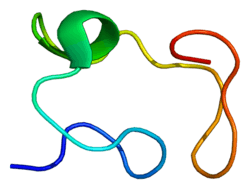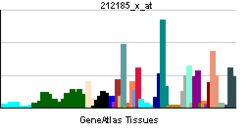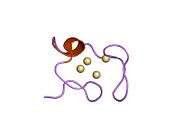Metallothionein 2A
Metallothionein-2 is a protein that in humans is encoded by the MT2A gene.[2][3]
Interactions
Metallothionein 2A has been shown to interact with Protein kinase D1.[4]
References
Further reading
- Kissling MM, Kägi HR (1977). "Primary structure of human hepatic metallothionein.". FEBS Lett. 82 (2): 247–50. doi:10.1016/0014-5793(77)80594-2. PMID 913597.
- Yamazaki S, Nakanishi M, Hamamoto T, et al. (1993). "Expression of human metallothionein-II fusion protein in Escherichia coli.". Biochem. Int. 28 (3): 451–60. PMID 1339282.
- Messerle BA, Schäffer A, Vasák M, et al. (1992). "Comparison of the solution conformations of human [Zn7]-metallothionein-2 and [Cd7]-metallothionein-2 using nuclear magnetic resonance spectroscopy.". J. Mol. Biol. 225 (2): 433–43. doi:10.1016/0022-2836(92)90930-I. PMID 1593628.
- Zafarullah M, Martel-Pelletier J, Cloutier JM, et al. (1992). "Expression of c-fos, c-jun, jun-B, metallothionein and metalloproteinase genes in human chondrocyte.". FEBS Lett. 306 (2-3): 169–72. doi:10.1016/0014-5793(92)80992-P. PMID 1633872.
- Messerle BA, Schäffer A, Vasák M, et al. (1990). "Three-dimensional structure of human [113Cd7]metallothionein-2 in solution determined by nuclear magnetic resonance spectroscopy.". J. Mol. Biol. 214 (3): 765–79. doi:10.1016/0022-2836(90)90291-S. PMID 2388267.
- Duguid JR, Bohmont CW, Liu NG, Tourtellotte WW (1989). "Changes in brain gene expression shared by scrapie and Alzheimer disease.". Proc. Natl. Acad. Sci. U.S.A. 86 (18): 7260–4. doi:10.1073/pnas.86.18.7260. PMC 298037
 . PMID 2780570.
. PMID 2780570.
- Karin M, Haslinger A, Heguy A, et al. (1987). "Metal-responsive elements act as positive modulators of human metallothionein-IIA enhancer activity.". Mol. Cell. Biol. 7 (2): 606–13. PMC 365115
 . PMID 3821726.
. PMID 3821726.
- Karin M, Haslinger A, Holtgreve H, et al. (1984). "Characterization of DNA sequences through which cadmium and glucocorticoid hormones induce human metallothionein-IIA gene.". Nature. 308 (5959): 513–9. doi:10.1038/308513a0. PMID 6323998.
- Schmidt CJ, Hamer DH, McBride OW (1984). "Chromosomal location of human metallothionein genes: implications for Menkes' disease.". Science. 224 (4653): 1104–6. doi:10.1126/science.6719135. PMID 6719135.
- Karin M, Richards RI (1982). "Human metallothionein genes: molecular cloning and sequence analysis of the mRNA.". Nucleic Acids Res. 10 (10): 3165–73. doi:10.1093/nar/10.10.3165. PMC 320698
 . PMID 6896577.
. PMID 6896577.
- Lambert E, Kille P, Swaminathan R (1996). "Cloning and sequencing a novel metallothionein I isoform expressed in human reticulocytes.". FEBS Lett. 389 (2): 210–2. doi:10.1016/0014-5793(96)00587-X. PMID 8766831.
- Woo ES, Dellapiazza D, Wang AS, Lazo JS (1999). "Energy-dependent nuclear binding dictates metallothionein localization.". J. Cell. Physiol. 182 (1): 69–76. doi:10.1002/(SICI)1097-4652(200001)182:1<69::AID-JCP8>3.0.CO;2-9. PMID 10567918.
- Jiang LJ, Vasák M, Vallee BL, Maret W (2000). "Zinc transfer potentials of the alpha - and beta-clusters of metallothionein are affected by domain interactions in the whole molecule.". Proc. Natl. Acad. Sci. U.S.A. 97 (6): 2503–8. doi:10.1073/pnas.97.6.2503. PMC 15958
 . PMID 10716985.
. PMID 10716985.
- Garrett SH, Sens MA, Shukla D, et al. (2000). "Metallothionein isoform 1 and 2 gene expression in the human prostate: downregulation of MT-1X in advanced prostate cancer.". Prostate. 43 (2): 125–35. doi:10.1002/(SICI)1097-0045(20000501)43:2<125::AID-PROS7>3.0.CO;2-S. PMID 10754528.
- Ebert MP, Günther T, Hoffmann J, et al. (2000). "Expression of metallothionein II in intestinal metaplasia, dysplasia, and gastric cancer.". Cancer Res. 60 (7): 1995–2001. PMID 10766190.
- Toyama M, Yamashita M, Hirayama N, Murooka Y (2003). "Interactions of arsenic with human metallothionein-2.". J. Biochem. 132 (2): 217–21. doi:10.1093/oxfordjournals.jbchem.a003213. PMID 12153718.
- Sun X, Kang YJ (2002). "Prior increase in metallothionein levels is required to prevent doxorubicin cardiotoxicity.". Exp. Biol. Med. (Maywood). 227 (8): 652–7. PMID 12192109.
- Strausberg RL, Feingold EA, Grouse LH, et al. (2003). "Generation and initial analysis of more than 15,000 full-length human and mouse cDNA sequences.". Proc. Natl. Acad. Sci. U.S.A. 99 (26): 16899–903. doi:10.1073/pnas.242603899. PMC 139241
 . PMID 12477932.
. PMID 12477932.
- Izmailova E, Bertley FM, Huang Q, et al. (2003). "HIV-1 Tat reprograms immature dendritic cells to express chemoattractants for activated T cells and macrophages.". Nat. Med. 9 (2): 191–7. doi:10.1038/nm822. PMID 12539042.
PDB gallery |
|---|
|
1mhu: THE THREE-DIMENSIONAL STRUCTURE OF HUMAN [113CD7] METALLOTHIONEIN-2 IN SOLUTION DETERMINED BY NUCLEAR MAGNETIC RESONANCE SPECTROSCOPY 1mrb: THREE-DIMENSIONAL STRUCTURE OF RABBIT LIVER CD7 METALLOTHIONEIN-2A IN AQUEOUS SOLUTION DETERMINED BY NUCLEAR MAGNETIC RESONANCE 1mrt: CONFORMATION OF CD-7 METALLOTHIONEIN-2 FROM RAT LIVER IN AQUEOUS SOLUTION DETERMINED BY NUCLEAR MAGNETIC RESONANCE SPECTROSCOPY 2mhu: THE THREE-DIMENSIONAL STRUCTURE OF HUMAN [113CD7] METALLOTHIONEIN-2 IN SOLUTION DETERMINED BY NUCLEAR MAGNETIC RESONANCE SPECTROSCOPY |


 . PMID 2780570.
. PMID 2780570. . PMID 3821726.
. PMID 3821726. . PMID 6896577.
. PMID 6896577. . PMID 10716985.
. PMID 10716985. . PMID 12477932.
. PMID 12477932.


